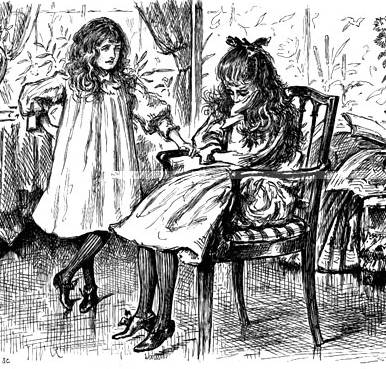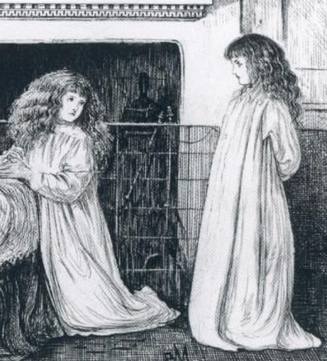The author has graciously shared with readers of the Victorian Web this passage from the second edition of her Fashion in Costume, 1200-2000 (2000), published by A & C Black (Publishers) Ltd., which retains copyright. Readers wishing to obtain the book can e-mail the following address: sales@acblack.com.
The practice of dressing children in adult styles gradually declined during thc second half of the 19th century. Boys benefited from more convenient and comfortable clothes earlier than girls, who had to wait until the late 1880s before enjoying clothes as casy as their grandmothers' had been or which began to resemble boys' styles rather than women's, although there was a considerable current of feeling against squeezing girls into corsets during the 1860s.

Boys still wore frocks with pleated skirts, or tunics and blouses over pleated skirts, until the age of three or four. Winterhalter's portrait of the Prince of Wales in a Scottish kilt in 1849 gave rise to a considerable vogue for pleated skirts; 'The costume worn by the Prince of Wales when at Balmoral has set the fashion of adapting the complete Highland costume', stated the Lady's Newspaper in 1852. 'Scotch' suits were worn from 1850 to the 1870s, but less frequently after that. In the 1860s a boy's suit might reflect the true Scottish costume: 'a waistcoat and jacket of velvet with a kilt of tartan poplin, plus scarf, brooch, sporran and Glengarry cap, if the jacket is of cloth, then woollen plaid is used for the kilt.' (Englishwoman's Domestic Magazine, 1867). But some very quaint travesties of Scottish dress were considered ideal for boys, and there was a profusion of 'Young Highlanders' wherever European fashion was followed, especially in America.
Boys between the age of three and seven had their sartorial problems solved during the 1860s by the knickerbocker suit, probably first developed in America, consisting of full knickerbockers, closed under the knee and a short collarless jacket fastening at the neck only (resembling the women's zouave jacket) over a white frilled shirt. In the 1870s the knickerbocker suit was worn until the age of ten or so, with a waistcoat and jacket in serge, cloth, melton or washable materials such as drill, the edges braided. The knickerbockers, were narrower by the 1880s, and by the end of the century they might hang loose like trousers cut off below the knee.



Along with the popularity of the knickerbocker suit came a naval influence, again starting with the young Prince of Wales being dressed in naval uniform, and later encouraged when his two young sons appeared in similar outfits. 'Sailor suits are always popular, and ever since the Prince of Wales' two sons have adopted the naval uni orm, the preference has increased', said the Queen Magazine in 1879 - and the fashion lasted into the early 20th century. The 1860s sailor suit consisted of a blouse with square collar worn with knickerbockers and a hat with a straight, narrow brim and low flat crown trimmed with black ribbon with bow ends. By the late 1870s the suit had many variations, with blouse or jacket, knickerbockers open or closed below the knee, or bell-bottomed trousers. The middy suit had a jacket and the Jack Tar suit a blouse, both worn with long trousers, in blue serge for winter and white drill for summer. These suits 'sold in their thousands' in the 1880s according to The Lady's Magazine.
As with men and women, the amount of complicated clothing worn by children during the late 19th century seems astonishing today. Eleanor Acland in Goodbyefor the Present recalls wearing underwear around 1880 that included a vest, a calico chemise reaching the knees, stays of wadded pique' buttoned down the back with additional buttons at varying levels around the waist to support drawers, stocking suspenders and a flannel petticoat, long black wool or thick cotton stockings, and over all a white petticoat with a bodice.
References
Nunn, Joan. Fashion in Costume, 1200-2000. 2nd edition. A & C Black (Publishers) Ltd; Chicago: New Amsterdam Books, 2000.
Last modified 11 June 2001